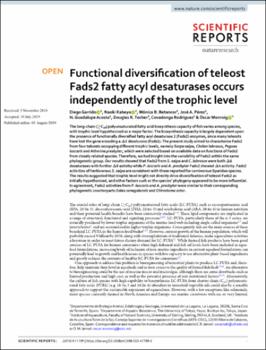Functional diversifcation of teleost Fads2 fatty acyl desaturases occurs independently of the trophic level
Fecha
2019Resumen
The long-chain (≥C20) polyunsaturated fatty acid biosynthesis capacity of fsh varies among species,
with trophic level hypothesised as a major factor. The biosynthesis capacity is largely dependent upon
the presence of functionally diversifed fatty acyl desaturase 2 (Fads2) enzymes, since many teleosts
have lost the gene encoding a Δ5 desaturase (Fads1). The present study aimed to characterise Fads2
from four teleosts occupying diferent trophic levels, namely Sarpa salpa, Chelon labrosus, Pegusa
lascaris and Atherina presbyter, which were selected based on available data on functions of Fads2
from closely related species. Therefore, we had insight into the variability of Fads2 within the same
phylogenetic group. Our results showed that Fads2 from S. salpa and C. labrosus were both Δ6
desaturases with further Δ8 activity while P. lascaris and A. presbyter Fads2 showed Δ4 activity. Fads2
activities of herbivorous S. salpa are consistent with those reported for carnivorous Sparidae species.
The results suggested that trophic level might not directly drive diversifcation of teleost Fads2 as
initially hypothesised, and other factors such as the species’ phylogeny appeared to be more infuential.
In agreement, Fads2 activities from P. lascaris and A. presbyter were similar to their corresponding
phylogenetic counterparts Solea senegalensis and Chirostoma estor






